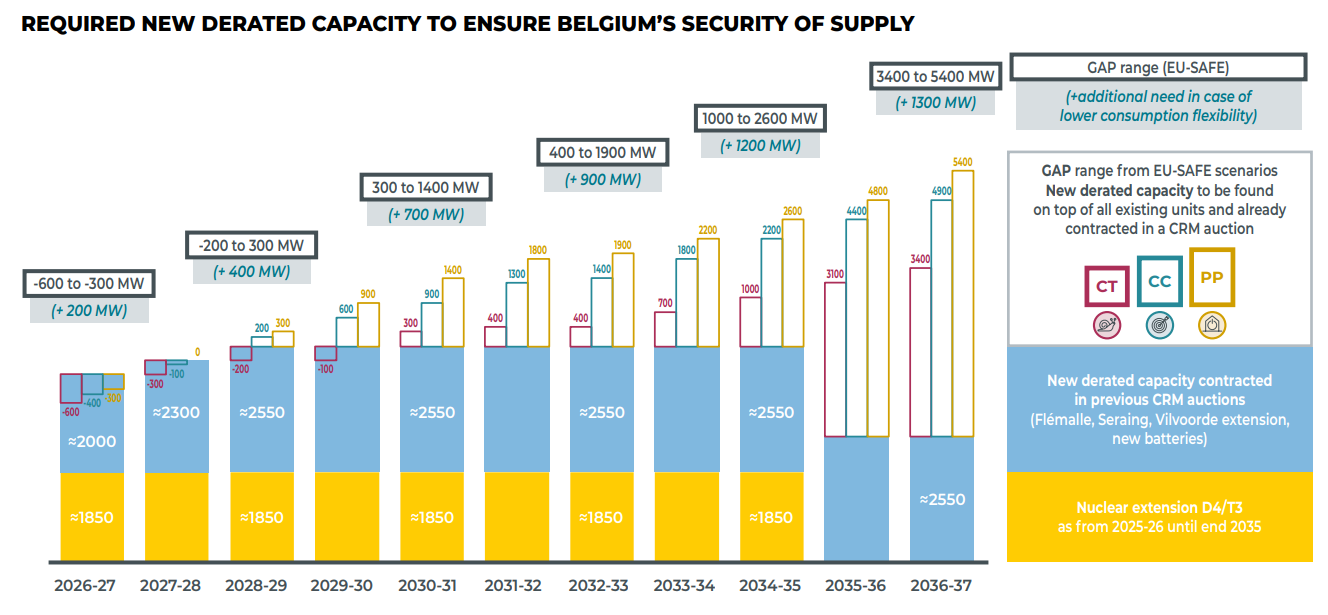Capacity Remuneration Mechanism (CRM)
The CRM ensures that there is sufficient capacity to meet peak load during scarcity moments by remunerating the capacity(ies) participating for their contribution to Security of Supply.
Discover the different phases within the CRM
What is the CRM?
Ensuring Belgium’s security of supply
The CRM aims to compensate capacity holders facing a ‘missing money’ issue meaning that their investment costs are not compensated by their potential revenues from the energy market. Such complementary remuneration aims at enabling current and new capacities to arrive or remain available on the market to avoid future adequacy issues.
To get the full picture and the legal information on the CRM please consult the legal framework of the CRM (below) and the functioning rules, which are explained and published on theproduct design page.
How to participate to the CRM?
There are 5 main steps to participate to the CRM:
- Prequalification: During prequalification you can register a Delivery Point with Elia, either to fulfil your legal obligation or to determine the Eligible Volume to participate to the CRM. If you only want to fulfil your legal obligation, but have no intention to bid in the Auction this is the only required step
- Bidding: You can bid your eligible capacity at a Bid Price of your choice, but within the applicable price caps, with your prequalified unit(s) in the auction
- Capacity contract: : If your bid is accepted, the next step is to sign the Capacity Contract which formalizes the agreement into a legally binding contract
- Pre-delivery monitoring: During pre-delivery monitoring, Elia verifies the ability of the Contracted Capacity to provide the capacity
- Remuneration, payback, and availability: Be available at adequacy relevant moments, collect remuneration and pay back if day ahead electricity price exceeds the Strike Price
CRM quick facts
-
Why CRM?
The CRM wants to ensure security of supply through two main actions:
1. Keep existing capacity in the market ;
2. Attract new capacities to fill in the gap required to meet Belgium’s reliability standard.
This is demonstrated on the graph below where the new amount of capacity that Belgium will need to meet its reliability standard over the coming decade is shown. Additional capacity is needed on top of the already contracted new capacities in the CRM and the partial nuclear prolongation. The volume of new capacities depends on the scenario and is shown in the bars. This volumes comes on top of the existing capacity which would need to remain in the market as well (the black line at the bottom). Without such additional support measures, the Adequacy and Flexibility study 2026-2036 also demonstrated that these new capacities would not be developed and that existing capacities would leave the market.

Source: Adequacy and Flexibility study 2026-2036 (Elia, 2025)
-
Can the CRM be combined with energy market revenues?
As the CRM is a support mechanism for assets facing a ‘missing money’ issue, it comes on top of regular energy market revenues. It is therefore possible to combine revenues from the energy markets and/or from the provision of balancing and redispatching services to Elia with the CRM.
-
Who can participate?
Every grid user (or mandated counterparty) with its production, DSM or storage unit(s) on all voltage levels can participate to the CRM. For some grid users, participation is mandatory. To bid, you need to respect some requirements such as a the minimal derated capacity of 1MW, being below the CO2 threshold (as currently defined in the CRM Functioning Rules)and you need to renounce other forms of variable subsidies. More information on prequalification page.
-
Who must participate?A subset of Belgian Capacity Holders is required to take part in the CRM Prequalification Process (see prequalification page for more information on mandatory participation).
-
When does the CRM process take place?The CRM was approved by the European Commission for a period of 10 years from 2025 to 2034. Yet, the different steps of the CRM cycle take place each year. The first step that needs to be followed to participate to the Auction is to prequalify your unit(s): to do so, a Prequalification File has to be submitted by June 15 in accordance with the deadlines defined in the Electricity Act. After being successfully prequalified, a bid can be submitted in the auction by the CRM candidate.
If a capacity is selected in the Auction (Y-4, Y-2 or Y-1), the “pre-delivery period” starts and lasts until the start of the Delivery Period. More information below at ‘What is the timeline to participate’.
The CRM also features a Secondary Market, which enables Capacity Providers to transfer their obligation to another CMU. The Secondary Market is open and continuously available for participation.
This timing is different for cross border capacity participation to the CRM, for more information on the timing for cross border capacity please consult theCross border participation design note -
What is the remuneration if I participate?
Following the selection of a Bid, the remuneration takes place on a pay as bid basis. That means if your bid is accepted, the remuneration will be equal to your Bid Price in the Auction.. You can get an indication of the potential remuneration of your assets viaWatts.happening - Monetise your power portfolio.
There are caps in place for the maximum bid price that apply to every Auction. New capacities with an Investment Files are subject to the Global Auction Price Cap. Existing capacities (with or without an Investment File) are subject to the Intermediate Price Cap (IPC).
-
Can I participate in combination with other variable subsidies?It is not possible to combine the CRM with other forms of variable subsidies.(e.g. Green certificates, CHP certificates). Therefore, when submitting a Prequalification File, candidates must provide a document labelled ‘Renunciation to Operating Aid’ in which they acknowledge that they will renounce to such subsidies if they’re selected in the Auction.
What is the timeline to participate
The timeline to participate is shown below:
This figure refers to a one-year contract, but in addition to one-year contracts, the CRM allows for multi-year contracts (up to maximum 3, 8, or 15 years for new capacities and up to 8 years for existing capacities) if specific Investment Thresholds are exceeded and upon regulatory approval.
Note that in this figure there is an extra step present, which is calibration. Calibration refers to the technical and regulatory process used to determine the key parameters and requirements for the several CRM auctions, such as the volume of capacity to be contracted and the specific market thresholds (like the Strike Price), as well as the applicable Derating Factors.
The calibration happens in accordance with the process set out in the legal framework, involving the different stakeholders (market parties, FPS Economy, CREG, Minister of Energy & Elia). Final parameters are fixed for every Auction by the minister via a Ministerial Decree. More information can be found onthe calibration page.


